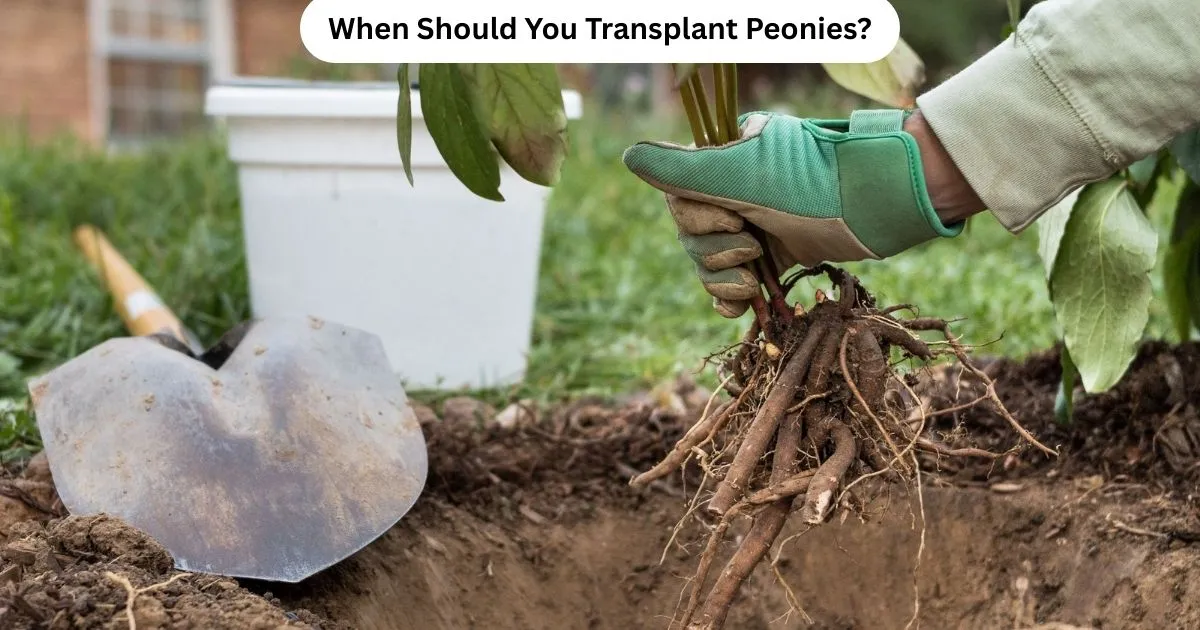Transplanting peonies can be a great way to give them a fresh start in a new location, ensuring they continue to thrive and bloom beautifully. However, it’s essential to do this at the right time to avoid stress and damage to the plant.
Understanding when to transplant peonies and how to care for them during the process can make a significant difference in their growth. This guide will help you learn the best time to move your peonies and provide tips for a successful transplant.
Read More: When Should You Cut Back Peonies?
Understanding the Peony Plant
Peonies are known for their large, fragrant blooms and long lifespan. They can live for decades, sometimes even outlasting the gardener who plants them. However, despite their resilience, peonies do need to be transplanted occasionally. Whether due to overcrowding, changing garden plans, or poor growing conditions, transplanting your peony may be necessary to keep it healthy.
When transplanting a peony, it’s important to understand its growth cycle. Peonies typically bloom in late spring or early summer. Their roots are sensitive, and transplanting them at the wrong time can cause them to go dormant or fail to bloom for a year or more.
Best Time to Transplant Peonies
The best time to transplant peonies is in the fall or early spring. Fall transplanting is ideal because it gives the plant a chance to establish its roots before the ground freezes. Early spring, before new growth starts, is also a good time because the plant is still dormant and less stressed.
Avoid transplanting peonies during their blooming period in late spring or summer. At this time, the plant is actively growing, and moving it can damage its roots and hinder flower production. Transplanting during the growing season is not recommended unless absolutely necessary.
Signs Your Peony Needs to Be Transplanted
Sometimes, a peony’s location or growth conditions may no longer suit its needs. Signs that a peony may need to be transplanted include overcrowding, poor blooms, or a plant that has outgrown its space. If the roots are pushing up through the soil or if the plant is failing to thrive, it might be time to move it.
Another sign is if the plant has been in the same spot for many years and is no longer producing large, healthy flowers. This could indicate that the soil has become depleted of nutrients or that the peony needs more space to grow.
Preparing the New Location
Before transplanting a peony, it’s essential to prepare the new location. Choose a spot that receives at least six hours of sunlight each day, as peonies thrive in full sun. The soil should be well-drained but rich in organic matter. You can improve soil quality by mixing in compost or other organic materials.
Dig a hole that is wide enough to accommodate the peony’s root ball without crowding. The depth should allow the plant’s eyes (buds) to be positioned at the same depth as they were in the original location. This ensures that the plant can continue to grow and bloom properly in its new spot.
How to Dig Up a Peony for Transplanting
When digging up a peony, take care to avoid damaging its roots. Start by carefully loosening the soil around the plant. Use a spade or shovel to gently lift the root ball from the ground. Try to keep as much of the root system intact as possible.
Once the plant is lifted, inspect the roots. If they are very large or crowded, you may want to divide the root ball. This can help the plant grow better in its new location. Make sure to keep the roots moist during the transplanting process to prevent them from drying out.
Planting the Peony in the New Spot
After you’ve prepared the new location and dug up the peony, it’s time to plant it. Place the peony in the hole, ensuring that the eyes are positioned at the right depth. Gently fill in the hole with soil, pressing it down lightly to eliminate air pockets.
Water the peony thoroughly after planting. This helps settle the soil and encourages the roots to start growing into their new environment. Be sure to keep the plant watered throughout the fall or early spring to help it adjust to the new location.
Aftercare for Transplanted Peonies
Once transplanted, peonies require careful attention to ensure they thrive. In the first few weeks after transplanting, the plant may not show much growth. This is normal as it focuses on establishing its roots in the new soil. Avoid fertilizing too soon, as this can stress the plant.
Continue to water the peony regularly, but be careful not to overwater, as this can lead to root rot. If transplanting in the fall, apply a layer of mulch around the base of the plant to protect the roots from winter temperatures. In spring, once the plant begins to grow, you can gradually start fertilizing it with a balanced, slow-release fertilizer.
Common Transplanting Mistakes to Avoid
One of the most common mistakes when transplanting peonies is placing them too deep in the ground. The eyes of the plant should be just a few inches below the soil surface. Planting them too deep can prevent them from blooming or cause them to die.
Another mistake is transplanting at the wrong time. Peonies should be transplanted in the fall or early spring when they are dormant. If you transplant during the blooming season, the stress can damage the plant and reduce its ability to flower in the future.
Conclusion
Transplanting peonies requires careful planning and timing to ensure their continued health and growth. The best times to move them are during their dormant periods in fall or early spring, allowing the plant to establish roots without stress. Preparing the new location with proper soil, sunlight, and space is crucial for successful transplanting.
By avoiding common mistakes and providing aftercare such as proper watering and fertilization, you can help your peony adjust and thrive. With the right care, transplanted peonies can continue to bloom beautifully for many years, enhancing your garden’s beauty season after season.
FAQ’s
When is the best time to transplant peonies?
The best time to transplant peonies is in fall or early spring when they are dormant.
Can peonies be transplanted during their blooming season?
No, transplanting during blooming can stress the plant and affect flowering.
How deep should peonies be planted after transplanting?
Peonies should be planted with their eyes about 2-3 inches below the soil surface.
Should I water transplanted peonies immediately?
Yes, water thoroughly after transplanting to help settle the soil around the roots.
How long does it take for transplanted peonies to bloom again?
It may take a season or two for transplanted peonies to bloom again.









